Figure 1.
Sources of serine. (A) Serine can be uptaked across cell membranes through the transporters SLC7A10/SLC3A2 (in nerve cells) and SLC1A4/SLC1A5 (in other cells). (B) Serine can be produced by degradation of serine-containing proteins in the lysosome, a process that breaks down proteins which are deactivated or misfolded, such as macropinocytosis and autophagy. (C) Serine can be synthesised from glycine via the catalysis of serine hydroxymethyltransferase (SHMT1/2). (D) Serine can be generated de novo through serine synthesis pathway (SSP). The 3-phosphoglycerate (3-PG) produced by glycolysis or gluconeogenesis is first catalyzed by phosphoglycerate dehydrogenase (PHGDH) to turn into 3-phosphohydroxypyruvate (3-PH), which is combined with a molecule of glutamic acid to produce phosphoserine through the work of phosphoserine aminotransferase 1 (PSAT1), and phosphoserine is finally hydrolyzed into serine by the action of phosphoserine phosphatase (PSPH). Serine directly binds and promotes allosteric activation of the glycolytic enzyme M2 isoform of pyruvate kinase (PKM2), by contrast, PHGDH can be inhibited by serine.

